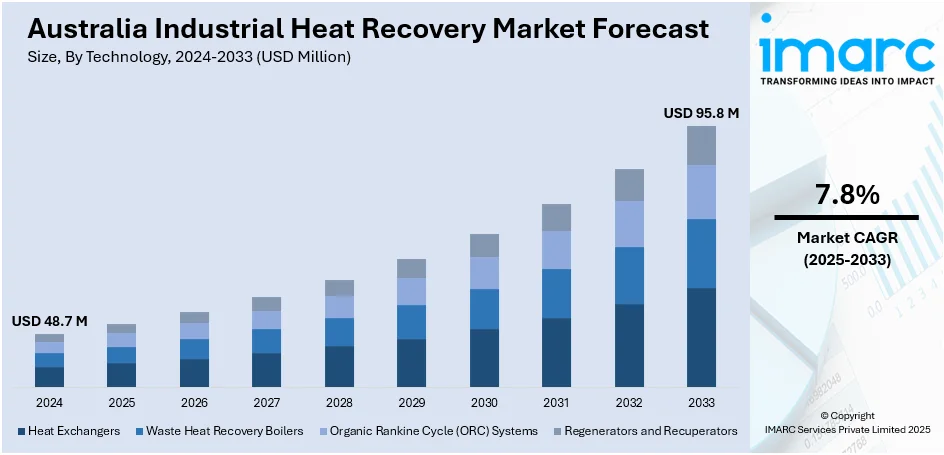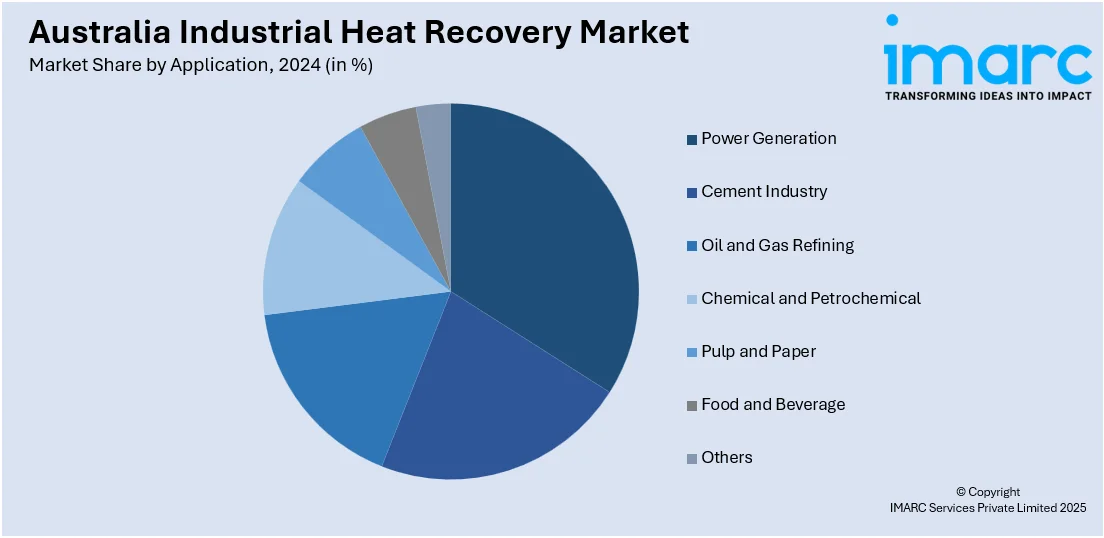
Australia Industrial Heat Recovery Market Size, Share, Trends and Forecast by Technology, Application, End Use Sector, and Region, 2025-2033
Australia Industrial Heat Recovery Market Overview:
The Australia industrial heat recovery market size reached USD 48.7 Million in 2024. Looking forward, IMARC Group expects the market to reach USD 95.8 Million by 2033, exhibiting a growth rate (CAGR) of 7.8% during 2025-2033. At present, the growing utilization of heat recovery solutions to decrease dependence on external power in remote mining sites, where energy supply can be expensive and limited, is positively influencing the market. Besides this, rising energy costs, which are encouraging industries, businesses, and households to seek more efficient ways to reduce energy usage, are contributing to the expansion of the Australia industrial heat recovery market share.
|
Report Attribute
|
Key Statistics
|
|---|---|
|
Base Year
|
2024 |
|
Forecast Years
|
2025-2033
|
|
Historical Years
|
2019-2024
|
| Market Size in 2024 | USD 48.7 Million |
| Market Forecast in 2033 | USD 95.8 Million |
| Market Growth Rate (2025-2033) | 7.8% |
Australia Industrial Heat Recovery Market Trends:
Rising mining activities
Increasing mining activities are offering a favorable market outlook. According to the Australian Bureau of Statistics, by December 2024, spending on mineral exploration increased by 1.3%. Smelting, refining, crushing, and ventilation are some of the processes used in mining operations that produce a lot of waste heat. Mining firms can minimize fuel utilization and support other processes by capturing and reusing waste heat through the implementation of heat recovery systems. As mining operations are expanding to supply the global demand for minerals like copper, iron ore, and lithium, heat recovery is becoming particularly crucial. By reducing greenhouse gas emissions enhancing overall energy optimization, heat recovery systems also help businesses comply with environmental standards. In remote mining sites, where energy supply can be limited, heat recovery offers a practical way to optimize resources and reduce reliance on external power. Additionally, mining companies are employing sustainable practices to meet environmental, social, and governance (ESG) goals, making heat recovery technology a key part of their strategy. The technology is applied in both above-ground and underground operations, enhancing overall productivity. As mining activities continue to rise across Australia, the demand for reliable and efficient heat recovery systems is growing, strengthening their role in supporting sustainable mining operations.

To get more information on this market, Request Sample
Increasing energy costs
Rising energy costs are propelling the Australia industrial heat recovery market growth. As electricity and fuel prices are increasing, there is a rising interest in solutions that can capture and reuse waste heat from processes, such as manufacturing and power generation. Heat recovery systems help refine energy efficiency by employing this excess heat to warm water, air, and other materials, decreasing the need for additional energy input. In commercial buildings and industrial facilities, this is leading to reduced operational costs and a smaller carbon footprint. The demand is especially strong in sectors like food processing, mining, and chemicals, where high-temperature processes generate significant waste heat. Rising energy costs are also encouraging stringent energy regulations and incentives for adopting energy-efficient technologies, further supporting heat recovery solutions. In residential applications, heat recovery ventilation systems aid in enhancing indoor comfort while minimizing heating and cooling bills. As energy prices remain volatile, the utilization of heat recovery systems is growing steadily across Australia, making them an important solution for energy savings and sustainability. As per the information provided on the official website of the Australian government authorities, the Australian Energy Regulator (AER) released a report regarding energy prices surpassing USD 5,000 per megawatt hour (MWh) in the National Electricity Market (NEM) as well as in New South Wales, Queensland, and South Australia, along with Frequency Control Ancillary Services (FCAS) markets in Queensland exceeding USD 5,000 per megawatt (MW) throughout October, November, and December 2024.
Australia Industrial Heat Recovery Market Segmentation:
IMARC Group provides an analysis of the key trends in each segment of the market, along with forecasts at the country and regional levels for 2025-2033. Our report has categorized the market based on technology, application, and end use sector.
Technology Insights:
- Heat Exchangers
- Waste Heat Recovery Boilers
- Organic Rankine Cycle (ORC) Systems
- Regenerators and Recuperators
The report has provided a detailed breakup and analysis of the market based on the technology. This includes heat exchangers, waste heat recovery boilers, organic rankine cycle (ORC) systems, and regenerators and recuperators.
Application Insights:

- Power Generation
- Cement Industry
- Oil and Gas Refining
- Chemical and Petrochemical
- Pulp and Paper
- Food and Beverage
- Others
A detailed breakup and analysis of the market based on the application have also been provided in the report. This includes power generation, cement industry, oil and gas refining, chemical and petrochemical, pulp and paper, food and beverage, and others.
End Use Sector Insights:
- Heavy Industries
- Manufacturing and Processing
- Utilities
The report has provided a detailed breakup and analysis of the market based on the end use sector. This includes heavy industries, manufacturing and processing, and utilities.
Regional Insights:
- Australia Capital Territory & New South Wales
- Victoria & Tasmania
- Queensland
- Northern Territory & Southern Australia
- Western Australia
The report has also provided a comprehensive analysis of all the major regional markets, which include Australia Capital Territory & New South Wales, Victoria & Tasmania, Queensland, Northern Territory & Southern Australia, and Western Australia.
Competitive Landscape:
The market research report has also provided a comprehensive analysis of the competitive landscape. Competitive analysis such as market structure, key player positioning, top winning strategies, competitive dashboard, and company evaluation quadrant has been covered in the report. Also, detailed profiles of all major companies have been provided.
Australia Industrial Heat Recovery Market News:
- In January 2024, a feasibility study for Ingleburn and Yatala Heat Energy Recovery was conducted to create engineering solutions and a business case for recovering and reusing heat from manufacturing processes in Australia. It sought to facilitate rapid transformational enhancements in industrial renewable energy.
Australia Industrial Heat Recovery Market Report Coverage:
| Report Features | Details |
|---|---|
| Base Year of the Analysis | 2024 |
| Historical Period | 2019-2024 |
| Forecast Period | 2025-2033 |
| Units | Million USD |
| Scope of the Report |
Exploration of Historical Trends and Market Outlook, Industry Catalysts and Challenges, Segment-Wise Historical and Future Market Assessment:
|
| Technologies Covered | Heat Exchangers, Waste Heat Recovery Boilers, Organic Rankine Cycle (ORC) Systems, Regenerators and Recuperators |
| Applications Covered | Power Generation, Cement Industry, Oil and Gas Refining, Chemical and Petrochemical, Pulp and Paper, Food and Beverage, Others |
| End Use Sectors Covered | Heavy Industries, Manufacturing and Processing, Utilities |
| Regions Covered | Australia Capital Territory & New South Wales, Victoria & Tasmania, Queensland, Northern Territory & Southern Australia, Western Australia |
| Customization Scope | 10% Free Customization |
| Post-Sale Analyst Support | 10-12 Weeks |
| Delivery Format | PDF and Excel through Email (We can also provide the editable version of the report in PPT/Word format on special request) |
Key Questions Answered in This Report:
- How has the Australia industrial heat recovery market performed so far and how will it perform in the coming years?
- What is the breakup of the Australia industrial heat recovery market on the basis of technology?
- What is the breakup of the Australia industrial heat recovery market on the basis of application?
- What is the breakup of the Australia industrial heat recovery market on the basis of end use sector?
- What is the breakup of the Australia industrial heat recovery market on the basis of region?
- What are the various stages in the value chain of the Australia industrial heat recovery market?
- What are the key driving factors and challenges in the Australia industrial heat recovery market?
- What is the structure of the Australia industrial heat recovery market and who are the key players?
- What is the degree of competition in the Australia industrial heat recovery market?
Key Benefits for Stakeholders:
- IMARC’s industry report offers a comprehensive quantitative analysis of various market segments, historical and current market trends, market forecasts, and dynamics of the Australia industrial heat recovery market from 2019-2033.
- The research report provides the latest information on the market drivers, challenges, and opportunities in the Australia industrial heat recovery market.
- Porter's five forces analysis assist stakeholders in assessing the impact of new entrants, competitive rivalry, supplier power, buyer power, and the threat of substitution. It helps stakeholders to analyze the level of competition within the Australia industrial heat recovery industry and its attractiveness.
- Competitive landscape allows stakeholders to understand their competitive environment and provides an insight into the current positions of key players in the market.
Need more help?
- Speak to our experienced analysts for insights on the current market scenarios.
- Include additional segments and countries to customize the report as per your requirement.
- Gain an unparalleled competitive advantage in your domain by understanding how to utilize the report and positively impacting your operations and revenue.
- For further assistance, please connect with our analysts.
 Request Customization
Request Customization
 Speak to an Analyst
Speak to an Analyst
 Request Brochure
Request Brochure
 Inquire Before Buying
Inquire Before Buying




.webp)




.webp)












